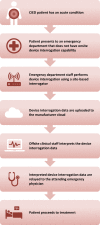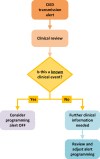2023 HRS/EHRA/APHRS/LAHRS Expert Consensus Statement on Practical Management of the Remote Device Clinic
- PMID: 37324757
- PMCID: PMC10264760
- DOI: 10.1002/joa3.12851
2023 HRS/EHRA/APHRS/LAHRS Expert Consensus Statement on Practical Management of the Remote Device Clinic
Abstract
Remote monitoring is beneficial for the management of patients with cardiovascular implantable electronic devices by impacting morbidity and mortality. With increasing numbers of patients using remote monitoring, keeping up with higher volume of remote monitoring transmissions creates challenges for device clinic staff. This international multidisciplinary document is intended to guide cardiac electrophysiologists, allied professionals, and hospital administrators in managing remote monitoring clinics. This includes guidance for remote monitoring clinic staffing, appropriate clinic workflows, patient education, and alert management. This expert consensus statement also addresses other topics such as communication of transmission results, use of third-party resources, manufacturer responsibilities, and programming concerns. The goal is to provide evidence-based recommendations impacting all aspects of remote monitoring services. Gaps in current knowledge and guidance for future research directions are also identified.
Keywords: Alerts; CIED; Cardiovascular implantable electronic device; Connectivity; Device clinic; Programming; Remote monitoring.
© 2023 Heart Rhythm Society, European Society of Cardiology, Asia Pacific Heart Rhythm Society, and the Latin American Heart Rhythm Society published by Elsevier Inc, Oxford University Press and Wiley.
Figures












Similar articles
-
2023 HRS/EHRA/APHRS/LAHRS expert consensus statement on practical management of the remote device clinic.Heart Rhythm. 2023 Sep;20(9):e92-e144. doi: 10.1016/j.hrthm.2023.03.1525. Epub 2023 May 19. Heart Rhythm. 2023. PMID: 37211145
-
2023 HRS/EHRA/APHRS/LAHRS Expert Consensus Statement on Practical Management of the Remote Device Clinic.Europace. 2023 May 19;25(5):euad123. doi: 10.1093/europace/euad123. Europace. 2023. PMID: 37208301 Free PMC article.
-
2021 PACES Expert Consensus Statement on the Indications and Management of Cardiovascular Implantable Electronic Devices in Pediatric Patients: Developed in collaboration with and endorsed by the Heart Rhythm Society (HRS), the American College of Cardiology (ACC), the American Heart Association (AHA), and the Association for European Paediatric and Congenital Cardiology (AEPC) Endorsed by the Asia Pacific Heart Rhythm Society (APHRS), the Indian Heart Rhythm Society (IHRS), and the Latin American Heart Rhythm Society (LAHRS).JACC Clin Electrophysiol. 2021 Nov;7(11):1437-1472. doi: 10.1016/j.jacep.2021.07.009. Epub 2021 Jul 29. JACC Clin Electrophysiol. 2021. PMID: 34794667
-
2019 HRS/EHRA/APHRS/LAHRS focused update to 2015 expert consensus statement on optimal implantable cardioverter-defibrillator programming and testing.Heart Rhythm. 2020 Jan;17(1):e220-e228. doi: 10.1016/j.hrthm.2019.02.034. Epub 2019 May 15. Heart Rhythm. 2020. PMID: 31103461 Review.
-
Remote Patient Monitoring: What Have We Learned and Where Are We Going?Curr Cardiovasc Risk Rep. 2023;17(6):103-115. doi: 10.1007/s12170-023-00720-7. Epub 2023 Apr 22. Curr Cardiovasc Risk Rep. 2023. PMID: 37305214 Free PMC article. Review.
Cited by
-
Barriers and Enablers to Routine Clinical Implementation of Cardiac Implantable Electronic Device Remote Monitoring in Australia Among Cardiologists, Cardiac Physiologists, Nurses, and Patients: Interview Study.JMIR Cardio. 2025 Jul 18;9:e67758. doi: 10.2196/67758. JMIR Cardio. 2025. PMID: 40680289 Free PMC article.
-
The prevalence of implantable cardioverter-defibrillator (ICD) and heart failure patients eligible for remote monitoring in Germany.BMC Cardiovasc Disord. 2024 Oct 17;24(1):572. doi: 10.1186/s12872-024-04245-8. BMC Cardiovasc Disord. 2024. PMID: 39420259 Free PMC article.
-
Seeing the Forest Through the Trees.JACC Adv. 2025 Apr;4(4):101655. doi: 10.1016/j.jacadv.2025.101655. Epub 2025 Mar 16. JACC Adv. 2025. PMID: 40096762 Free PMC article.
-
Optimizing remote heart failure management: First experiences with the HeartInsight score for implanted defibrillators.J Arrhythm. 2024 Mar 29;40(3):643-646. doi: 10.1002/joa3.13032. eCollection 2024 Jun. J Arrhythm. 2024. PMID: 38939800 Free PMC article.
-
The clinical use of remote parameter testing during cardiac implantable electronic devices implantation procedures: a single center, randomized, open-label, non-inferiority trial.Front Cardiovasc Med. 2024 Mar 22;11:1364940. doi: 10.3389/fcvm.2024.1364940. eCollection 2024. Front Cardiovasc Med. 2024. PMID: 38586175 Free PMC article.
References
-
- Graham R, Mancher M, Miller Wolman D, Greenfield S, Steinberg E, editors. Institute of Medicine Committee on Standards for Developing Trustworthy Clinical Practice Guidelines. Clinical Practice Guidelines We Can Trust. Washington DC: National Academies Press; 2011. - PubMed
Publication types
LinkOut - more resources
Full Text Sources

